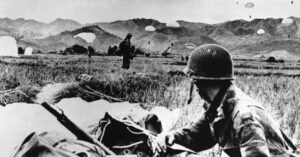It was midafternoon on one of the hottest days of the year. But as we descended the spiral staircase into the underground prison, the light quickly vanished. By the time we reached the main corridor it was as dark and cold as night. I tried to keep pace with my guide as his flashlight traced the graffitied, bloodstained walls.
We were beneath the summit of Coyotepe, a small mountain that rises over the city of Masaya in Nicaragua. The hilltop was once the site of a strategic fortress, built by José Santos Zelaya, an independent-minded president overthrown by the United States in 1909. The bunker housing the prison was built in 1936 by his eventual successor, the dictator Anastasio Somoza García, after he took power in a coup d’état. For the next forty-three years, Somoza and his heirs robbed the Nicaraguan people blind by controlling industries, seizing land, and taking a cut of everything from small businesses to foreign aid. They did so with the blessing of eight U.S. presidential administrations, who saw the Somozas as protectors of U.S. commercial interests—especially mining and banking—and a bulwark against communism. It was of the first Somoza that Franklin Delano Roosevelt apocryphally declared: “As a Nicaraguan might say, he’s a sonofabitch but he’s ours.”
Anyone who stood against the dictatorship risked being thrown into prisons like Fortaleza El Coyotepe, where they were tortured by special units of Somoza’s military, the U.S.-trained Guardia Nacional. Survivors were said to be driven mad by the dark. Use of the prison concluded a short time after the dynasty was overthrown in 1979 by the leftist Sandinista revolution. The Sandinistas handed it over to the youth scouting movement in 1983. Sandinista leader and Nicaragua’s current president Daniel Ortega has dreamed of turning it into a macabre tourist site. But as my guide, a volunteer with the scout troop, confirmed, I was the only foreign visitor that day.
My guide showed off the former cells, rattling off their capacities: eighty in this one, eighty-five in the next. He took me to a single toilet pit and shower shared by as many as fifty prisoners at a time. Finally, we reached a rusted door. “Here is one of the torture chambers,” he said, matter-of-factly, as he swung it open. It screeched, startling the bats who had been sleeping on the ceiling behind us. I walked in. He closed the door behind me, and all the outside noises ceased. “The prisoners in here lost all sense of time because they didn’t know whether it was morning, afternoon, or night,” he explained. “I’ll shut off the light so you can see.”
It was an ironic choice of words, but fitting in a way. Lost in the darkness, I felt a fleeting sense of what the jailers must have wanted their captives to feel: cut off from the rest of the world. Unshackled from my senses, I was overcome with a feeling of connection across time and space—not only with Somoza’s unlucky victims but the greater number of purported enemies of the United States and its proxies who have found themselves in spaces like this across the world. The outposts of American empire are seldom taught about in our schools and go all but unacknowledged in the movies, books, games, and monuments where our most deeply embedded narratives get passed on. Yet it is in hidden spaces like the underground torture chamber that the realities of American power can truly be seen.
Omission Creep
Invisibility is fundamental to the construction of empire. If citizens of the imperial center—the metropole, the “homeland”—could see how their nation’s wealth and power were really made and guarded, there would be few volunteers to fight in and administer the periphery. This has been seen throughout history: in the British people’s studied ignorance of their foreign service’s operations in Kenya or India; the quiet French acceptance “each time a head [was] cut off or an eye put out in Vietnam,” as Aimé Césaire wrote; the walls of official silence that surround the Chinese mass internment of Uyghurs in Xinjiang. The Swedish essayist Sven Lindqvist put it succinctly in his book Exterminate All the Brutes: “The men representing civilization out in the colonies were ‘invisible’ not only in the sense that their guns killed at a distance but also in that no one at home really knew what they were doing.” (In his 2021 television series of the same name, Haitian documentarian Raoul Peck read that line over a clip from Apocalypse Now, followed by archival footage of real American violence in the Vietnam War.)
Americans tend to recoil at the description of our country as an empire—or more precisely, the seat of one. It clashes with our self-image as a republic, “conceived in liberty, and dedicated to the proposition that all men are created equal,” and so on. But under any common definition—“a large territory or set of disparate territories encompassing many different peoples ruled by a single power, and without the consent of all those governed,” says the Oxford Dictionary of Human Geography—the United States has been an empire since at least the early twentieth century, if not throughout the conquest and resettlement of native lands in the centuries before.
A crucial turn came in 1901. That year, the U.S. Supreme Court began ruling that the territories the United States had recently seized from Spain were neither states nor foreign countries, but rather “foreign to the United States in a domestic sense.” In other words, they were colonies, ruled by but not entitled to representation in Washington. This arrangement still holds in Puerto Rico and Guam, as well as the U.S. Virgin Islands, American Samoa, and Northern Mariana Islands.
The conquest of the largest of those former Spanish colonies was especially difficult. Subduing the populous Philippine archipelago took over a decade of war, from 1899 to 1913; thousands of American soldiers and as many as 775,000 Filipinos died as a result of the first three years of fighting alone. (The Philippines remained a formal U.S. colony until 1946.) Into the midcentury, U.S. colonial power drew on past experiments of subtler and less direct forms of control. These techniques included “dollar diplomacy” (controlling a country by taking over its financial system—used in Nicaragua and Honduras), Wilsonian interventionism (military invasion followed by the propping up of a puppet government—for instance in Haiti from 1915–1934), and what journalist Vincent Bevins identified as the “Jakarta Method” (secret interventions, usually by the CIA, in support of authoritarian capitalist regimes that mass murdered suspected leftists—seen in Indonesia, Brazil, and Chile).
The result was a less formal empire than those of, say, Britain or France—one more easily hidden in an era of rising global mass communication. Throughout the twentieth century, the United States intervened around the world to secure raw materials for industry (eventually, and above all, oil), monopolize trade routes and markets, and suppress alternative visions and rival powers. Yet these actions were largely kept shielded from the voting and taxpaying American public, whose consent was needed to keep the imperial machine humming. The two-time-Medal-of-Honor recipient Smedley Butler, who led a charge up Coyotepe Hill in 1912, caused a national scandal seventeen years later when he joked during a mainland speaking tour about how his Marines had fixed a Nicaraguan presidential election in the wake of the battle. Butler was shocked that an American audience had no idea what he and his fellow Marines had been doing in their name in Nicaragua and elsewhere.
A History of Silence
Victory over the fascists and imperial Japan in World War II, as well as the emerging rivalry with the Soviets, strengthened American planners’ need to preserve their image as the avatar of liberal democracy. It was also the era when the last of the old European empires were breaking up in a wave of decolonization and independence struggles across Asia and Africa. An idea emerged at the Pentagon to address both concerns: Instead of subjugating entire peoples, why not just take the space we need and build a base far from prying eyes and major population centers? Dubbed the “Strategic Island Concept” in 1958 by a little-known civilian naval planner named Stuart B. Barber, it was first implemented over the following decade on the island of Diego Garcia in the middle of the Indian Ocean. By 1971, the entire native population of the tiny island had been expelled.
This was not a strictly new idea: it was similar to how Washington approached its first target of overseas expansionism, when it seized in perpetuity otherwise uninhabited land for a naval base at Guantánamo Bay, Cuba. Nor did it fully supplant the earlier forms of U.S. colonialism in Puerto Rico and elsewhere. But within this imperial palimpsest emerged what historian Daniel Immerwahr has called our “pointillist empire”—a system of some eight hundred bases in over seventy countries. This hidden network—representing more than 75 percent of all foreign bases held by any country in the world—is used for surveillance, broadcasting, and a variety of physical operations including barracks, runways, repair shops, jails, and ports. Some of these activities are admitted to in public. Others are covert, known in U.S. government argot as “black ops.”
In the years following the September 11 attacks, the hidden bases took on a purpose that seemed new to many. George W. Bush’s administration and his CIA embarked on what they called the “extraordinary rendition” and “enhanced interrogation” of terror suspects, often with the cooperation of client states like Poland, Thailand, and Afghanistan. The Somozas would have immediately recognized it as a program of kidnapping and torture.
The Bushies dubbed these secret torture prisons “black sites.” Their existence was only made known several years later, thanks largely to the work of investigative journalist Dana Priest. Leaks and a Senate investigation have since revealed some of what goes on inside the black sites, including waterboarding (a new spin on a water-torture technique first used by Americans in the Philippines), sexual assault, “stress positions,” and the freezing of a detainee to death.
But only in October 2021—twenty years after the War on Terror began—did the first testimony of a black-site prisoner become officially public. Majid Khan, a Pakistani man, grew up in the Baltimore suburbs before becoming a courier for al-Qaeda. He was captured in Karachi in 2003, then spent nearly two decades moving between secret prisons before ending up at Guantánamo. In exchange for cooperating in military and criminal prosecutions, the government granted Khan the chance to make a public statement about his experiences. For Khan, being seen was worth bargaining for.
The testimony is harrowing. Khan describes multiple sexual assaults by guards, both direct molestations as well as forcible insertions of “tubes or objects” into his rectum. He was also variously hung naked from a roof beam for days, waterboarded, and submerged in ice and water. When he tried to go on a hunger strike, his captors force-fed him through his nose and rectum, slathering hot sauce on and sharpening the tubes to heighten the pain.
A particular weapon of torture resounds through Khan’s testimony: the darkness. He describes having been moved to a “dark, underground prison” within the compound the Senate Select Committee on Intelligence has identified as “Detention Site Cobalt”—widely believed to be another name for the compound known as the “Salt Pit” outside Kabul. There was no need for a hood or blindfold because the room was “pitch black.” The only light came from the headlamps of CIA agents, who stripped Khan naked and short-shackled him to a wall, in a way that ensured he could not sit or kneel. To heighten the sense of disorientation, agents played music “constantly at deafening volumes.” “I remember thinking the room was shaking,” Khan said. “I remember the immense feeling of uncertainty that I felt. It was horrifying.” Khan remained in this state of total darkness for sixty days.
The supposed purpose of this procedure was to force Khan to give up information about planned attacks against U.S. citizens or allies. But Khan was just a courier—not a particularly well-connected one, it seems—and started cooperating immediately. As Spencer Ackerman wrote, “The CIA’s treatment of Khan suggests that the agency did not believe Khan mattered in the world of terrorism, or even possessed much intelligence to extract.” Even then, Khan was “mostly left to rot in his cell”—restricted to primarily solitary confinement for another eighteen years. While Khan prepared his testimony, the Biden administration was fighting in the Supreme Court to suppress the details of the torture of another detainee, a Saudi-born Palestinian man known as Abu Zubaydah.
An investigation by the Senate Intelligence Committee determined in 2014 that this torture program did not produce significant information. In fact, it was deemed to be often “counterproductive in the broader campaign against al-Qaeda.” Yet the alumni of the black site program—including Trump’s CIA director Gina Haspel and Obama’s CIA director John Brennan—have remained influential in public life. Their records have been bowdlerized and their torture-stained reputations burnished by major media and entertainment, including the fanciful account of the operation to kill Osama bin Laden offered by the Academy Award-nominated Zero Dark Thirty.
La Misma Cosa
Seen through the lens of America’s imperial history, a pattern becomes clear. From the Philippines to Vietnam, Coyotepe to the Salt Pit, the United States has consistently used both darkness and invisible spaces for the same essential purpose: to suppress its enemies and display its power in ways that allow it to preserve an illusion of republican innocence before its people. Zoom out even further and these spaces join an even larger constellation that includes immigrant detention centers and an ever-expanding system of U.S. domestic prisons—the largest the world has ever seen. Those thrown into it are magnified into super predators and super pariahs by the mystery surrounding their detention. The bigger and better-hidden the cage, the bigger we assume the monster must be inside—and the more powerful the forces must be that captured and subdued it. Even citizens who try to expose and stop the abuses risk being incarcerated as well, as the whistleblowing spy John Kiriakou learned.
In Nicaragua, the client Somoza regime was overthrown by a byproduct of the forces that created it. The Sandinista rebels took their inspiration from the revolutionary hero Augusto César Sandino—who in turn had been radicalized by the slaying of a previous rebel leader in a battle with Smedley Butler’s Marines atop Coyotepe back in 1912. Instead of dismantling the subterranean prison following their victory, the Sandinistas at first used it for revenge—turning its torture chambers against the Guardias who had once tortured them. It was a preview of the authoritarian turn the Sandinista movement would take under Daniel Ortega. Like his predecessors, the current Nicaraguan president has partaken in torture and political imprisonment. As protesters chanted in the streets during my visit to Nicaragua in 2019: “Daniel y Somoza, son la misma cosa,” or “Daniel and Somoza are the same thing.”
Dismantling these systems of oppression first requires shattering the myths surrounding them and then exposing—on a societal scale—the abuses happening inside. Exposing the gap between American ideals and the true nature of the exercise of American power in particular will not be easy to do. Stripping the leaders and organizations who have perpetrated these abuses of their prominence and holding them to account will surely provoke new spasms of reaction. But it is the only way.
After a few more seconds in the torture chamber, my guide flicked back on his lamp. The blast of light was blinding at first. But my eyes quickly adjusted as he led us both out of the darkness.
(Jonathan M. Katz is the author of Gangsters of Capitalism: Smedley Butler, the Marines, and the Making and Breaking of America’s Empire. He writes about politics and international affairs. Courtesy: The Baffler, America’s leading voice of interesting and unexpected left-wing political criticism, cultural analysis, short stories, poems and art.)




